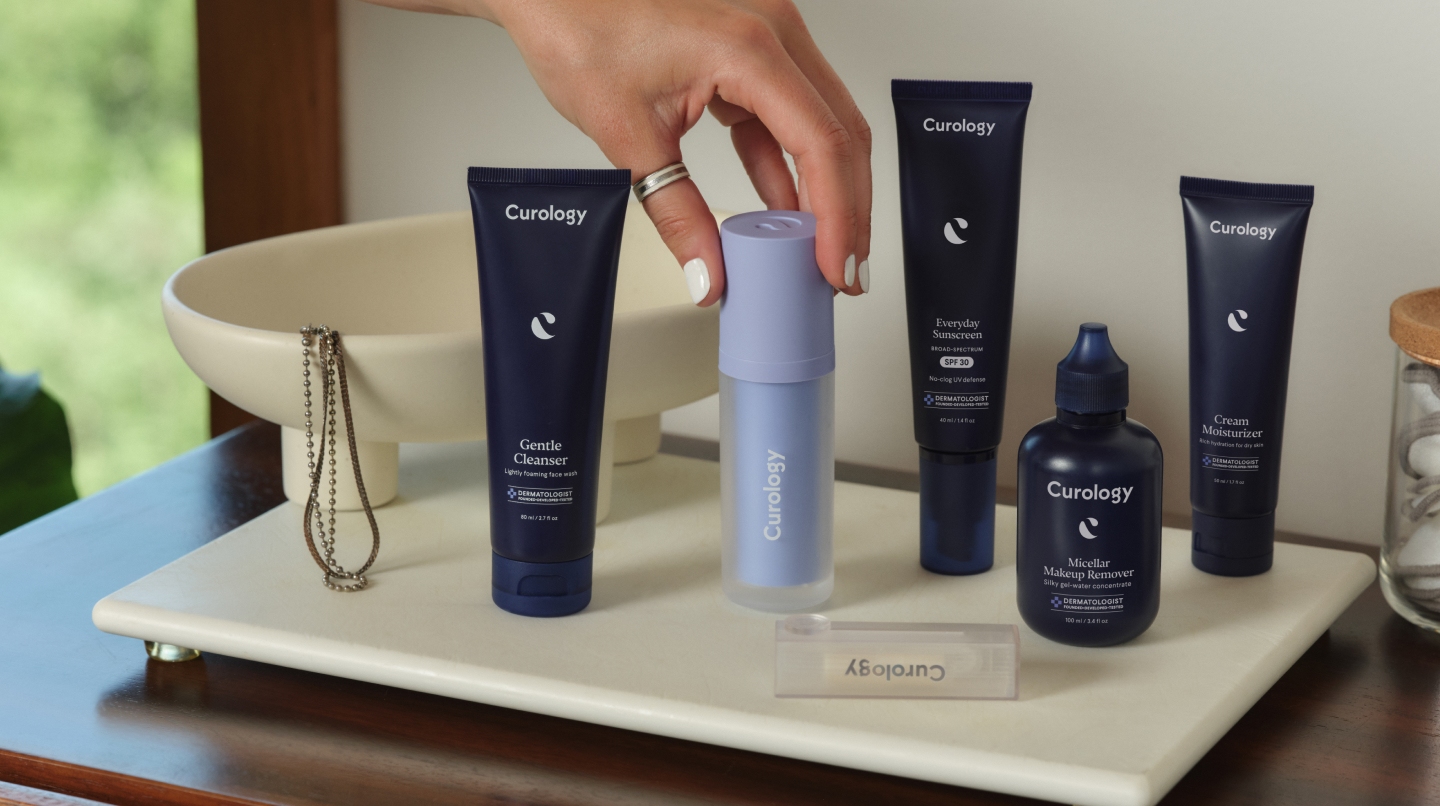How it works:
Share your skin goals and snap selfies
Your dermatology provider prescribes your formula
Apply nightly for happy, healthy skin
How it works:
How it works:
Share your skin goals and snap selfies
Your dermatology provider prescribes your formula
Apply nightly for happy, healthy skin
How it works:
How to treat and help prevent post-inflammatory erythema
This post-breakout condition might be just as frustrating as the breakout itself. Luckily, you can help prevent it from developing.



If there’s one thing more frustrating than an acne breakout, it’s having to deal with another skin concern once it clears up. Post-inflammatory erythema is a condition that causes reddish spots on the skin after lesions caused by acne or other skin injuries have healed. The good news? Several products exist to help minimize its appearance and eventually fade away. Here we’ll explain post-inflammatory erythema, its symptoms and contributing factors, and several effective ways to treat it.
What is erythema?
In short, erythema is a medical term for reddened skin, and several things can cause it.¹ Acne, specifically, can lead to post-inflammatory erythema, which causes pinkish and/or reddish spots to appear where inflammatory acne blemishes (papules or pustules) once were. Papules are red, inflamed acne lesions. Pustules are similar but have a white or yellow center or head. Post-inflammatory erythema forms when localized skin becomes pinkish/red following any type of skin inflammation.² Post-inflammatory erythema often fades with time, but using the right skincare products may help accelerate the process.
Potential post-inflammatory erythema causes
Post-inflammatory erythema can occur after an inflammatory event, including:
Acne lesions. Acne occurs when dead skin cells and excess sebum (skin oil) become trapped inside hair follicles. Bacteria (C. acnes) feed on the oil, leading to an inflammatory response and acne breakouts.
Squeezing or picking pimples. Popping doesn’t make acne disappear—on the contrary, it can actually make it worse! Picking, squeezing, and popping may worsen the inflammatory damage. It can also lead to acne scars.
How to get rid of post-inflammatory erythema
Specific skincare ingredients (and patience!) may help fade post-inflammatory erythema, but your best defense is prevention. Unfortunately, you may not be able to entirely prevent acne, but you can be proactive about minimizing it happening in the first place. It all starts with establishing good skincare habits and using products with effective ingredients.
At Curology, we believe in keeping things simple with a three-step approach that includes cleansing, moisturizing, and applying a broad-spectrum sunscreen with SPF 30 or higher by day and cleansing, moisturizing, and treating by night. We recommend using a cleanser and moisturizer that are suitable for your skin type.
If you’re looking for post-inflammatory erythema treatment options, here are some ingredients that may help fade the redness and even out skin tone and texture:
Clindamycin is a topical antibiotic that fights acne-causing bacteria and is used to treat inflamed papules and pustules that can lead to PIE. Clindamycin is clinically shown to reduce bacteria and inflammation and is generally well-tolerated.³
Azelaic acid has been shown to reduce unwanted pigmentation in the skin by selectively targeting hyperactive melanocytes (pigment-producing cells) while having little effect on normal melanocytes. In other words, it can be helpful in treating sun-induced dark spots, the dark spots that acne leaves behind, and other types of hyperpigmentation. Its anti-inflammatory and antibacterial properties also treat acne,⁴ which may help prevent post-inflammatory erythema.
Retinoids, such as tretinoin, increase cell turnover to help stimulate new, healthy skin growth. These powerful anti-inflammatory agents clear pores and boost collagen production.⁵ Tretinoin is available by prescription only, while retinol is available over the counter.

The power of antioxidants
Ultraviolet light is one of the leading mechanisms of oxidative stress, which degrades skin structure, accelerates skin aging, causes inflammation, and may contribute to acne vulgaris.⁶ Antioxidants scavenge free radicals and reduce oxidative stress while reducing inflammation, accelerating wound healing, and restoring the skin barrier.
Here are a few of our favorite antioxidants available over the counter:
Vitamin C is a potent antioxidant proven to help protect the skin against signs of aging—especially from UV exposure.⁷ Its anti-inflammatory properties may help reduce redness associated with post-inflammatory erythema. Vitamin C is a popular ingredient in skin-brightening creams and serums.
Niacinamide is a form of vitamin B3 (nicotinic acid, niacin), an ingredient that helps hydrate, boost collagen production, and even skin tone. Niacinamide also has anti-inflammatory and antioxidant properties that may reduce facial redness.⁸
Green tea’s antioxidant properties may help slow the signs of aging, reduce inflammation, and treat acne. Research suggests green tea may be as effective when consumed as when applied topically.⁹
Procedures to help with post-inflammatory erythema
Typically, post-inflammatory erythema fades on its own over time with the help of topical creams, gels, and serums. For more persistent post-inflammatory erythema, there are in-office procedures that may help. Always consult a board-certified dermatologist or licensed dermatology provider first:
Intense pulsed light therapy (IPL) is a treatment that has recently been shown to effectively treat acne-induced post-inflammatory erythema.¹⁰
Laser treatment can help even skin tone, but not without some risks. Laser therapy may cause pain and scarring.
Microneedling is often referred to as collagen induction therapy. Microneedling encourages collagen production by using tiny needles to puncture the skin.¹¹
Curology offers professional help for your skin needs
Curology’s licensed dermatology providers work to determine the proper routine for various skin concerns. We recommend skincare products with clinically researched ingredients you can trust, such as niacinamide, azelaic acid, and tretinoin.
We’re here to take the guesswork out of your skincare routine. Our licensed dermatology providers work with you to examine your skin, assess your skincare goals, and provide custom treatment options.
Signing up is easy. Just answer a few questions and snap a few selfies to help us get to know your skin better. If Curology is right for you, a licensed in-house dermatology provider will create a personalized prescription formula that targets your specific skin concerns.* They’re available to answer any skincare questions and modify your formula as your skin’s needs naturally shift over time.
FAQs
In short, erythema is a medical term for reddened skin, and several things can cause it. Acne, specifically, can lead to post-inflammatory erythema, which causes pinkish and/or reddish spots to appear where inflammatory acne blemishes (papules or pustules) once were. Papules are red, inflamed acne lesions.
If you’re looking for post-inflammatory erythema treatment options, here are some ingredients that may help fade the redness and even out skin tone and texture:
Clindamycin is a topical antibiotic that fights acne-causing bacteria and is used to treat inflamed papules and pustules that can lead to PIE.
Azelaic acid has been shown to reduce unwanted pigmentation in the skin by selectively targeting hyperactive melanocytes (pigment-producing cells) while having little effect on normal melanocytes.
Retinoids, such as tretinoin, increase cell turnover to help stimulate new, healthy skin growth.
P.S. We did the homework so you don’t have to:
Bae-harboe, Y.S.C. and Graber, E.M. Easy as PIE (post-inflammatory erythema). Journal of Clinical and Aesthetic Dermatology. (September 2013).
Bae-harboe, Y.S.C. and Graber, E.M. Easy as PIE (post-inflammatory erythema). Journal of Clinical and Aesthetic Dermatology. Ibid.
Zaenglein, A.L., et al. Guidelines of care for the management of acne vulgaris. Journal of the American Academy of Dermatology. (2016, May 1).
Zaenglein, Andrea L., et al. Guidelines of care for the management of acne vulgaris. Journal of the American Academy of Dermatology. Ibid.
Baldwin HE, et al. 40 Years of Topical Tretinoin Use is Review. Journal of Drugs in Dermatology. (June 2013).
Nakai, K. and Tsuruta, D. What are reactive oxygen species, free radicals, and oxidative stress in skin diseases? International Journal of Molecular Science. (2021).
Al-Niaimi F., et al. Topical Vitamin C and the Skin: Mechanisms of Action and Clinical Applications. The Journal of Clinical and Aesthetic Dermatology. (July 2017).
Vlase, L., et al. Mechanistic basis and clinical evidence for the applications of nicotinamide (niacinamide) to control skin aging and pigmentation. Antioxidants. (August 2021).
Di Sotto, A., et al. Efficacy and safety of oral green tea preparations on skin ailments: A systematic review of clinical studies. Nutrients. (August 2022).
Mathew, M.L., et al. Intense pulsed light therapy for acne-induced post-inflammatory erythema. Indian Dermatology Online Journal. (May-June 2018).
Deirdre Connolly, et al. Acne Scarring—Pathogenesis, Evaluation, and Treatment Options. J Clin Aesthet Dermatol. (September 2017).
Erin Pate is a board-certified Family Nurse Practitioner at Curology. She earned her Masters of Science in Nursing at Florida Atlantic University in Boca Raton, FL.
* Subject to consultation. Subscription is required. Results may vary.

Curology Team

Erin Pate, NP-C
Related Articles
Men skin care: top concernsFace sunscreen for sensitive skinSunscreen for eyes: How to protect your delicate skin from UV raysYour first weeks on CurologyWrinkles and other signs you’re doing it rightPopular Articles
Ask Curology: Is my cold breaking me out?Slugging: The dermatologist-approved skincare hack going viral on TikTokTretinoin vs retinol: What’s the difference?How to create a self-care routine that actually sticksYour 2023 skincare horoscopeTry prescription skincare
Get routine essentials

Good skin days ahead
- Breakouts
- Redness
- Fine lines
- Dark spots
- Hair thinning